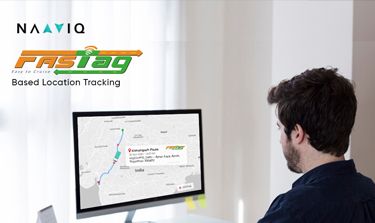
1. Traffic Congestion
Among the vehicle routing and scheduling problems, traffic congestion is one of the most generalized and frustrating ones. Delivery routes may become longer because of traffic congestion thereby causing delay in the deliveries, disruption in the scheduled activities and increased use of fuel. These conditions within the transport networks are very dynamic, with the offender’s ability to comply with the routed plan becoming very difficult.
Solution: Real-Time Traffic Data and Dynamic Routing
Dynamic routing through real-time data is the ultimate solution for traffic congestion. Thanks to NaaviQ’s transport management system (TMS) provision of live traffic updates, organizations do not need to wait until the planned destination is reached in order to alter vehicle routes. The system analyzes traffic conditions on an ongoing basis, thus enabling it to suggest the optimal path for the vehicles in transit minimizing delays and fuel consumption. The system also has the capability of recommending alternative routing patterns in the event of unforeseen road obstructions ensuring that deliveries are completed as scheduled.
2. Unpredictable Weather Conditions
There is no denying that even the most meticulously planned detours can be ruined by unexpected changes in the weather. For instance, adverse weather conditions such as heavy downpours, snow blizzards or even fog may hinder the achievement of set goals by risking delays in delivery due to prolonged transportation.
Solution: Weather-Integrated Route Planning
In order to lessen the effects of weather elements on vehicle routing optimization, organizations can include weather forecasting as a component of their TMS. For instance,NaaviQ’s platform uses advanced weather forecasting mechanisms to re-route delivered vehicles subjected to unfavorable weather conditions. In the event of an impending storm in a particular geographic area, the system is able to suggest other possible routes or delay the delivery of the consignment. Such functionality enhances delivery reliability and also improves safety for the drivers as well.
3. Fuel Costs and Environmental Impact
The inflation of fuel prices and the need for environmental sustainability are two of the most worrying issues for supply chain players. Inefficient pathways may result in excessive fuel consumption, thereby increasing costs as well as carbon emissions.
Solution: Fuel-Efficient Route Optimization
A vehicle for transport management can be propelled up thanks to NaaviQ's TMS which provides a range of fuel-efficient routing algorithms considering among other things traffic, terrain and vehicle load. Companies can lead the charge towards reduction in fuel use and hence carbon emissions through route optimization for fuel consumption. NaaviQ’s solution also allows fleet managers to track their fuel consumption in real-time, which helps in making tactical changes to help save more costs. This is not only advantageous to the finances of the company but also helps in achieving greater environmental objectives.
4. Driver Shortages and Fatigue
The global logistics sector is grappling with an acute crisis regarding the availability of competent drivers which is adversely affecting the already affected available drivers. Driver fatigue remains a key concern as it may result in accident occurrence, inefficiencies, and breaches in restrictions imposed on driving hours.
Solution: Efficient Driver Scheduling and Route Assignment
NaaviQ's platform meets this challenge by enhancing the smart scheduling of systems and optimizing routing. The system assigns routes considering the existing drivers and their hours of service (HOS) working limits in a way that keeps them within regulatory limits but strives to achieve the least number of fatigue hours for the drivers. Also, the TMS is capable of making real-time schedule changes and accordingly incurs changes in routes, so that operations and safety are never compromised. This ensures that drivers get an even distribution of work and minimizes the chances of accidents resulting from tiredness.
5. Multiple Delivery Stops and Time Windows
Numerous organizations face the challenges of vehicle routing, particularly when many delivery points are involved, and each point has its particular time window. Time-sensitive delivery failures can result in customer dissatisfaction, or even worse, penalties in some instances.
Solution: Advanced Route Planning and Time Window Optimization
The Transportation Management System (TMS) offered by NaaviQ is the best in managing complicated deliveries with various time bound stops. The system employs complex routines to ascertain the best order of stops while ensuring that all deliveries take place within their stipulated periods. Taking it a stage further, NaaviQ helps businesses observe even the most stringent of deadlines without pushing their drivers extremely or hampering effectiveness by considering travel times, traffic patterns, and delivery priorities. This resulted to higher satisfaction among clients and fewer fines as a result of applied time windows being missed.
6. Vehicle Maintenance and Breakdowns
Unforeseen mechanical failures of vehicles can greatly affect the routing of vehicles leading to delays in delivery and increased operational expenses. Secondly, if the fleet is not properly maintained, its reliability can decrease, resulting in more frequent breakdowns and unplanned idling of the fleet.
Solution: Predictive Maintenance and Fleet Monitoring
The TMS developed by NaaviQ incorporates tools for predictive maintenance allowing organizations to keep track of the status of their fleet in real-time. The system uses internal data from onboard vehicle sensors to determine the likelihood of failure of a given vehicle and automatically schedules its maintenance in a timely manner, which reduces the incidences of failed equipment. The system also oversees and automates the scheduling of routine checks to make sure that the equipment is always at its best. This forward-thinking approach reduces the idle time of the fleet and enhances operational efficiency.
7. Customer Expectations and Last-Mile Delivery
Today’s customers are demanding quick, versatile, and accurate delivery services in this age of digitization. In particular, last-mile delivery presents a challenge to the vehicle routing problem since it often entails urban driving, traffic management, and the need for speedy deliveries.
Solution: Last-Mile Optimization and Customer Communication
NaaviQ has developed advanced optimization methods to streamline last-mile delivery considerably. Several urban traffic factors were integrated into the optimization, such as the destination of the customers and the hours when delivery is to be completed. In addition to this system, tools for real-time communication have also been integrated into the system enabling the customers to track their orders and receive accurate ETAs. This is beneficial in enhancing customer service as well as reducing the chances of missed or failed delivery attempts thereby making last mile operations even more efficient.
Conclusion
Vehicle routing in practice is faced with a number of factors which are quite complicated, however when appropriate technology and strategies are employed, then such challenges can easily be solved. NaaviQ’s holistic TMS tackles all these issues from dynamic routing to fuel efficiency, driver safety, last mile as well as every last detail in the transport and logistics processes. Companies that use these implements and technologies are able to optimize their processes, save resources, and improve customer experience within the safe confines of the law and environmentally friendly practices.
Winning the battle of supply chain management in the present scenario entails effective control of vehicle routing. With the knowledge and innovative technology of NaaviQ, organizations are able to handle vehicle routing effectively to ensure that their supply chains remain operational even when faced with practical challenges.




